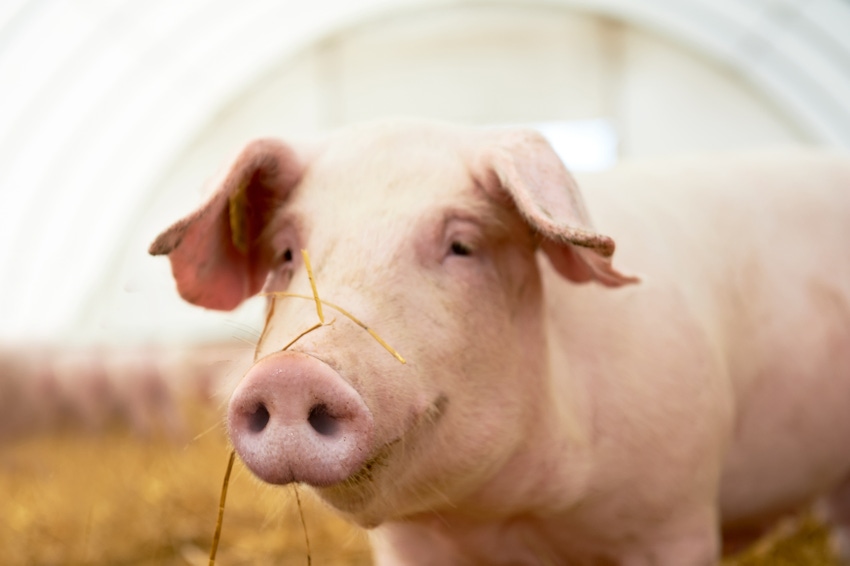Daily gain and carcass characteristics not affected by rice bran, but meat quality may be influenced.
June 28, 2018

Rice is the third-most widely grown cereal grain worldwide, and the bran left over from milling white rice is available in large quantities for livestock feed, according to the University of Illinois.
While that rice bran is high in unsaturated fatty acids, limited information is available about the effects rice bran has on the growth performance of grow/finish pigs and its effects on meat and carcass quality. Therefore, a new study was conducted at the University of Illinois to provide this information, the announcement said.
Hans H. Stein, a professor in the University of Illinois department of animal sciences, explained, “Pigs deposit fatty acids in approximately the same proportions as they consume them from the diet. Also, if pigs consume a diet containing a large amount of fat, they will synthesize less fat on their own, which can change the fatty acid composition, because the fat synthesized by the pig tends to be more saturated.”
More unsaturated fat can lead to softer bellies, which have a shorter shelf life, increased susceptibility to becoming rancid and reduced sliceability, the university said.
Stein and a team of researchers conducted an experiment using 224 barrows and gilts over a period of 97 days. A three-phase feeding program was used with grower, early-finisher and late-finisher diets. In each phase, diets containing 10%, 20% or 30% full-fat or defatted rice bran were fed, as was a basal corn/soybean meal diet.
"We observed no effect of feeding rice bran on carcass characteristics, but there were some differences in meat quality, especially protein and fat percentage and marbling,” Stein said.
The protein content of the loin muscle was 7.0% and 8.7% greater, respectively, for pigs fed the greatest amount of full-fat or defatted rice bran than for pigs fed the basal diet, Stein reported. The fat content was reduced in pigs fed the maximal amount of full-fat rice bran by 26% and 31% for pigs fed full-fat and defatted rice bran, respectively. The marbling score was 1.88 in meat from pigs fed the basal diet but decreased to 1.00 and 1.25 for the 30% full-fat and defatted rice bran diets, respectively.
Belly fat was softer if rice bran was included in the diets, the researchers said. The iodine value of belly fat — a measure of unsaturation — increased as more full-fat rice bran was included in the diet; however, feeding up to 30% defatted rice bran did not affect the iodine value.
“The iodine value of fat from the pigs fed diets with full-fat rice bran is probably greater because those diets contained up to twice as much fat as the basal or defatted rice bran diets,” Stein said. “So, the pigs synthesized less fat.”
Over the 97-day experimental period, average daily gain was not affected by diet. However, average daily feed intake increased as the inclusion rate of defatted rice bran increased, whereas the opposite was true when full-fat rice bran was included in the diets, the researchers said. As a consequence, the gain-to-feed ratio was greater in pigs fed diets containing full-fat rice bran than defatted rice bran or the basal diet.
Stein said the results demonstrate that rice bran can be used in pig diets, but there are trade-offs. "Including 30% full-fat rice bran in diets for growing/finishing pigs may improve gain:feed without affecting carcass characteristics or meat quality, although polyunsaturated fatty acids in adipose tissues will increase. However, including up to 30% defatted rice bran will reduce gain:feed ratio without affecting the loin muscle quality or composition of adipose tissues," he said.
"Thus, it is a matter of ingredient costs to determine if it is economical to include full-fat rice bran or defatted rice bran in diets for growing/finishing pigs,” he added. “We hope that this information will help producers and feed companies make more informed choices about the use of rice bran in swine diets.”
The paper was co-authored by Gloria Casas, Martin Overholt, Anna Dilger and Dustin Boler with the University of Illinois and was published in the Journal of Animal Science.
You May Also Like


.png?width=300&auto=webp&quality=80&disable=upscale)
